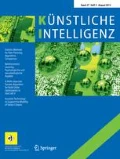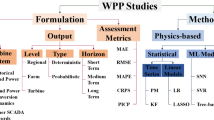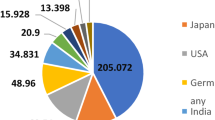Abstract
Wind power has become one of the renewable resources with a major growth in the electricity market. However, due to its inherent variability, forecasting techniques are necessary for the optimum scheduling of the electric grid, specially during ramp events. These large changes in wind power may not be captured by wind power point forecasts even with very high resolution numerical weather prediction models. In this paper, a fuzzy approach for wind power ramp characterisation is presented. The main benefit of this technique is that it avoids the binary definition of ramp event, allowing to identify changes in power output that can potentially turn into ramp events when the total percentage of change to be considered a ramp event is not met. To study the application of this technique, wind power forecasts were obtained and their corresponding error estimated using genetic programming and quantile regression forests. The error distributions were incorporated into the characterisation process, which according to the results, improve significantly the ramp capture. Results are presented using colour maps, which provide a useful way to interpret the characteristics of the ramp events.














Similar content being viewed by others
References
WWEA (2012) World wind energy half-year report 2012, Technical report. World Wind Energy Association
Ferreira C, Gama J, Matias L, Botterud A, Wang J (2010) A survey on wind power ramp forecasting, Technical report. ARL, DIS-10-13
Pinson P (2009) Catalogue of complex extreme situations. Technical report, EU Project SafeWind, Deliverable Dc1.2
Bossavy A, Girard R, Kariniotakis G (2013) Forecasting ramps of wind power production with numerical weather prediction ensembles. Wind Energy 16(1):51–63
Martínez-Arellano G, Nolle L (2013) Genetic programming for wind power forecasting and ramp detection. In: Research and development in intelligent systems XXX, pp 403–417
Giebel G (2011) The state of the art in short-term prediction of wind power: a literature overview, 2nd edn, Project ANEMOS. http://www.safewind.eu/images/Articles/Deliverables/swind_deliverable_dp-1.4_sota_v1.1.pdf. Accessed 17 Sept 2013
Kanamitsu M, Alpert JC, Campana KA, Caplan PM, Deaven DG, Iredell M, Katz B, Pan HL, Sela J, White GH (1991) Recent changes implemented into the global forecast system at NMC. Weather Forecast 6:425–435
Landberg L (1999) Short-term prediction of the power production from wind farms. J Wind Eng Ind Aerodyn 80:207–220
Landberg L (2001) Short-term prediction of local wind conditions. J Wind Eng Ind Aerodyn 89:235–245
Constantinescu EM, Zavala EM, Rocklin M, Lee S, Anitescu M (2011) A computational framework for uncertainty quantification and stochastic optimization in unit commitment with wind power generation. IEEE Trans Power Syst 26:431–441
Skamarock WC, Klemp JB, Dudhia J, Gill DO, Barker DM, Wang W, Powers JG (2001) A description of the advanced research WRF Version 2, available from NCAR, vol 88, pp 7–25
Alexiadis MC, Dokopoulos PS, Sahsamanoglou H, Manousaridis IM (1998) Short-term forecasting of wind speed and related electrical power. Sol Energy 63(1):61–68
Lazić L, Pejanović G, Živković M (2010) Wind forecasts for wind power generation using Eta model. Renew Energy 35(6):1236–1243
Monteiro C, Bessa R, Miranda V, Botterud A, Wang J, Conzelmann G, Porto I et al (2009) Wind power forecasting: state-of-the-art 2009. Tech. rep, Argonne National Laboratory (ANL)
Costa A, Crespo A, Navarro J, Lizcano G, Madsen H, Feitosa A (2008) A review on the young history of the wind power short-term prediction. Renew Sustain Energy Rev 12(6):1725–1744
Foley AM, Leahy PG, Marvuglia A, McKeogh EJ (2012) Current methods and advances in forecasting of wind power generation. Renew Energy 37(1):1–8. doi:10.1016/j.renene.2011.05.033
Sweeney CP, Lynch P (2010) Adaptative post-processing of short-term wind forecasts for energy applications. Wind Energy. doi:10.1002/we.420
Salcedo-Sanz S, Ortiz-García EG, Portilla-Figueras A, Prieto L, Paredes D (2009) Hybridizing the fifth generation mesoscale model with artificial neural networks for short-term wind speed prediction. Renew Energy 34(6):1451–1457
Zhao P, Wang J, Xia J, Dai Y, Sheng Y, Yue J (2012) Performance evaluation and accuracy enhancement of a day-ahead wind power forecasting system in China. Renew Energy 43:234–241
Delle Monache L, Nipen T, Liu Y, Roux G, Stull R (2011) Kalman filter and analog schemes to postprocess numerical weather predictions. Mon Weather Rev 139(11):3554–3570
Cassola F, Burlando M (2012) Wind speed and wind energy forecast through Kalman filtering of numerical weather prediction model output. Appl Energy 99:154–166
Salcedo-Sanz S, Ortiz-García EG, Pérez-Bellido AM, Portilla-Figueras A, Prieto L (2011) Short term wind speed prediction based on evolutionary support vector regression algorithms. Expert Syst Appl 38(4):4052–4057
Zhang Y, Wang J, Wang X (2014) Review on probabilistic forecasting of wind power generation. Renew Sustain Energy Rev 32:255–270
Bourke W (2004) Performance of the ECMWF and the BoM ensemble systems in the southern hemisphere. Mon Weather Rev 132:2338–2357
Toth Z, Kalnay E (1993) Ensemble forecasting at NMC: the generation of perturbation. Bull Am Meteorol Soc 74:2317–2330
Arribas A, Robertson KB, Mylne KR (2005) Test of a poor man’s ensemble prediction system for short-range probability forecasting. Mon Weather Rev 133:1825–1839
Greaves B, Collins J, Parkes J, Tindal A (2009) Temporal forecast uncertainty for ramp events. Wind Eng 33(11):309–319
Cutler NJ, Outhred HR, MacGill IF, Kepert JD (2009) Characterizing future large, rapid changes in aggregated wind power using numerical weather prediction spatial fields. Wind Energy 12(6):542–555
Gallego C, Costa A, Cuerva A, Landberg L, Greaves B, Collins J (2013) A wavelet-based approach for large wind power ramp characteristaion. Wind Energy 16(2):257–278
Michalakes J, Vachharajani M (2008) GPU acceleration of numerical weather prediction. Parallel Process Lett 18(4):531–548
Martínez-Arellano G, Nolle L, Bland J (2012) Improving WRF-ARW wind speed predictions using genetic programming. SGAI’12 conference, pp 347–360
Tindal A, Johnson C, LeBlanc M, Harman K, Rareshide E, Graves A (2008) Site-especific adjustments to wind turbine power curves. AWEA wind power conference
Koza JR (1992) Genetic programming: on the programming of computers by means of natural selection. MIT Press, Cambridge
Poli R, Langdon B, McPhee NF (2008) A field guide to genetic programming with contributions by J. R. Koza, Published via http://lulu.com and freely available at http://www.gp-field-guide.org.uk
Kotanchek ME, Vladislavleva EY, Smits GF (2010) Genetic programming theory and practice VII. Springer, New York
Sotavento Galicia Experimental Wind Farm. http://www.sotaventogalicia.com. Accessed 29 April 2013
Pinson P (2006) Estimation of the uncertainty in wind power forecasting. PhD Thesis, Ecole des Mines de Paris, Paris, France
Kariniotakis G et al (2004) What performance can be expected by short-term wind power prediction models depending on site characteristics? In: CD-proceedings of the 2004 European wind energy conference, EWEC04, London, UK
Meinshausen N (2006) Quantile regression forests. J Mach Learn Res 7:983–999
Zadeh LA (1965) Fuzzy sets. Inf Control 8:338–353
Author information
Authors and Affiliations
Corresponding author
Rights and permissions
About this article
Cite this article
Martínez-Arellano, G., Nolle, L., Cant, R. et al. Characterisation of Large Changes in Wind Power for the Day-Ahead Market Using a Fuzzy Logic Approach. Künstl Intell 28, 239–253 (2014). https://doi.org/10.1007/s13218-014-0322-3
Received:
Accepted:
Published:
Issue Date:
DOI: https://doi.org/10.1007/s13218-014-0322-3




